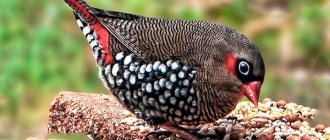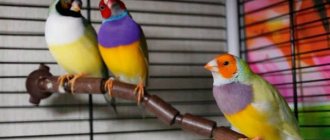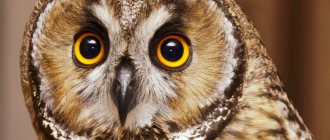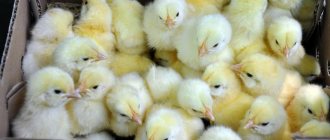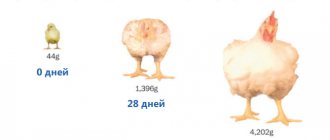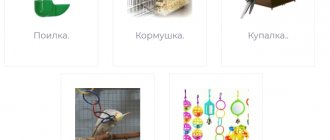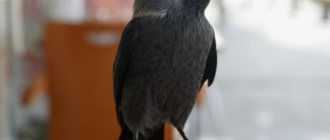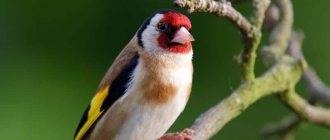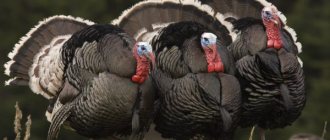Finches are small birds from the family of Finches, which are often kept at home. These birds are very sociable and cannot stand being alone, so they are usually kept in pairs or groups. In such conditions, many owners begin to strive to obtain offspring from their pets. Amadins are easy to breed in captivity, but the emerging finch chicks require special care and proper care from the poultry farmer, which will allow them to be raised into healthy birds.
After how many days and how do finches chicks hatch?
The female lays up to 5 eggs per clutch and begins the incubation process with the last egg so that all the chicks hatch at the same time. The male also participates in brooding, replacing the mother. This is the time she eats and rests.
The chicks hatch on days 12–18, depending on the variety. First, they use their beaks to break through the eggshell from the inside. It looks like a straight line around the entire circumference of the egg. Next, the chick pushes itself out of the “house”, straightening its body, and gets out.
Did you know? If a female pecks at a male and shows aggression towards him in every possible way, she is not ready to mate and lay eggs.
The appearance of eggs and chicks
When all preparations are made and the pair is formed, eggs can be expected to appear. The first will be 7 days after mating and then one egg will be laid per day.
Development by day
The development of finches occurs as follows:
| Age in days | State of the art |
| 3 | The babies begin to squeak. Outwardly they also look unattractive, but their body size increases noticeably. |
| 5–7 | Eyes open, appearance becomes more pleasant for owners. The chicks begin to fledge. |
| 17–20 | The chicks begin to try to “escape” from the nest. Some just fall out of it. There is no need to panic, you just need to carefully place them in place. A quiet squeak turns into a real noise. |
| 21–24 | The finches independently get out of the nest and return back without outside help. At this stage, parents can stop feeding, and then you will have to monitor the nutrition. |
Zebra finches - history, description
The homeland of finches is Australia. From there they independently moved to East Timor and Indonesia. Thanks to their attractive coloration, the birds were quickly appreciated by the first colonists. And later people transported them to America, where they also took root well - today you can see wild birds in the southern United States, as well as in Brazil and Puerto Rico.
Zebra finch
Finches cannot be called large - most often their body length is about 10 cm. But the coloring is quite rich and attractive. The powerful beak, which is deep orange and sometimes almost red, makes it easy to collect seeds from the ground, which form the basis of their diet.
The difference between a female and a male
It is quite difficult to confuse a female with a male - the former, like most animals and birds, are distinguished by more modest colors. Both birds have a gray color; in females it is varied only by white cheeks and vertical black stripes under the eyes. The belly is slightly lighter than the back.
Male and female finch
A male is a completely different matter. Their beak is brighter, and their chest is decorated with a zebra pattern, in which black and white feathers gracefully alternate. The breast is almost white and is bordered on top by an elongated black spot. The cheeks are decorated with bright orange spots, and the wings are brown with small white patches.
The chicks are not so beautiful. Their beak is black and their color is gray.
Note! It is not worth keeping finches alone - they are flocking birds, and they feel uncomfortable alone.
What to feed finches chicks at home
With careful selection of parents and a high level of their consciousness, there is no need to worry about the nutrition of babies during the first 3 weeks. But if everything happened exactly the opposite, then responsibility for the diet falls on the shoulders of the breeder.
Natural feeding
The first time after birth, the female is responsible for feeding the offspring, while the male feeds only her at this time. Babies signal their hunger not only by squeaking, but also by wide-opening their beaks.
After 10–15 days, the father of the family also joins in feeding the babies. Your task during this period is to take care of the nutrition of the adults. After 3–4 weeks, when the chicks are already flying out of the nest, the female stops caring about their diet.
Important! The male does not leave the children until they begin to feed on their own.
How to feed yourself
If for some reason you have to feed the chicks yourself, be prepared for the fact that this is done not only during the day, but also at night. During the first 3 days of life, babies require food every hour, and at night - 2 hours. From days 4 to 7, during daylight hours the frequency of feeding does not change, but during dark hours it increases to 3 hours. From days 8 to 15, the intervals are increased to 1.5–2 hours and 6 hours, respectively. From days 16 to 30, finches are fed every 2–4 hours during daylight hours and every 6 hours during dark hours.
For this purpose, special mixtures for feeding chicks or baby food that does not contain milk are used. The mixture is stirred with hot water (60 °C) until it becomes mushy. Babies are fed only after the gruel has cooled to 39 °C. Food is administered using a syringe (without a needle) with a silicone nozzle.
Familiarize yourself with the peculiarities of keeping siskin, crossbill, goldfinch, falcon, and carrion crow at home.
On day 30, finches are taught to feed themselves. To do this, the same mixtures or crushed boiled grains are placed in feeders. Recommended volume - 1 tsp. Feeding frequency: 5–6 times a day.
After another 7 days they begin to produce mash, and another 7 - grains and seeds. At this time, night feeding stops. As soon as the offspring gets stronger, they are moved into a cage with adults, who will teach them all the skills necessary for life.
Video: Feeding chicks
Features of behavior
But despite the unpretentiousness of finches in general, certain difficulties may well arise when maintaining them. It is necessary to know about them in order to be able to quickly take appropriate measures to solve problems. So, it will be very useful to describe them.
Reason for plucking a couple's feathers
Very often, having placed a couple in one cage and expecting that the birds will very soon begin building a nest and give birth, the breeder is puzzled by their behavior. Instead, they behave aggressively and even pluck each other's feathers. What is the reason for this behavior?
There may be several reasons for this. Firstly, there is not enough material to build a nest - the couple tries to make it softer, and in the absence of other fluff, they use their own. Secondly, this may indicate a lack of vitamins in the male’s body - at least if he not only plucks feathers, but also eats them. The problem can be solved by using mineral supplements as a top dressing.
Healthy! To prevent the birds from getting bored, it is worth hanging a mirror or a bell in the cage. They will keep birds occupied for a long time and distract them from aggression towards others.
Finally, the third case is the saddest. It's just a bad character in the bird. Yes, this also happens. The male gets bored and attacks the female, plucking her feathers. Nothing can be done about this - it is advisable to plant them. Such a male cannot be used for reproduction - there is a high probability that the habit will be passed on to the offspring.
Why do females and males fight?
It also happens that a couple of finches, instead of living in perfect harmony, organize real battles for survival - feathers fly in different directions. Moreover, this happens both before laying eggs and after several appear in the nest.
The situation is very unpleasant - the clutches will have to be sacrificed, and the birds will have to be placed in separate cages. After a few weeks, you can bring them together again and carefully monitor the reaction. If it happens again, then the couple is simply incompatible - you need to exchange the male for another, if possible. It is possible that in another pair he will show his best side.
Another variety is the Gouldian finch.
Note! However, this also happens in cases where a cage that is too small in size is used - the birds are cramped, which provokes them into conflict.
Can birds live alone?
Often people do not want to have a pair of finches or more: maybe the size of the cage does not allow or there is no desire to get offspring from birds. Therefore, the question arises: is it possible to have one bird?
In general, this is, of course, possible. But a lonely finch will definitely not be happy. On the one hand, simply because he does not have a company to play with. On the other hand, being alone is always a source of stress. In the wild, finches, like most small birds, always live in flocks. An individual that strays from it automatically becomes a victim of any bird of prey. Although there is no such danger in the cage, the birds feel constant discomfort. This can lead to consequences such as:
- refusal to sing,
- poor appetite
- low activity,
- dulling of plumage.
Note! In addition, finches kept in individual cages live several years less than those in a school. This is worth remembering before getting a pet.
Caring for chicks
Caring for chicks begins from the first days of birth. With responsible parents, you won’t have to worry about heating and feeding your babies. If finches refuse to take care of their offspring, it is advisable to use the services of bird nannies - species of birds with a developed maternal instinct. Or take full responsibility upon yourself.
Take care of heating. Place the chicks in a “house” (for example, a box with a nest). Cover it with cotton cloth and ensure the following temperature conditions in the room:
- Days 1–7 — 37 °C;
- 8–14 days - 34 °C;
- 15–20 days - 24 °C.
The recommended air humidity level is 60–70%.
The chicks are fed very often and only with high-quality food. Feeding begins only after the baby has emptied. Important! Untimely feeding can lead to gastric blockage and death of the bird.
Color of birds
The color of finches is extremely diverse and one can use it to determine their habitats: birds living in temperate latitudes have brown, white and fawn colors. But the inhabitants of the tropics are dressed smartly - combinations of red and black, blue and green, purple and yellow are not uncommon here.
How does bird migration occur?427223.560
Males of some species of finches tend to change their clothes before the mating season, after which they become similar to their girlfriends. True, the color of the male still remains brighter than that of the females: such clothing is intended to lead the enemy away from the nest in case of danger - while the females that hatch the eggs should be as inconspicuous as possible.
Scientists have recently established an interesting fact: the color of the feathers on a finch’s head fully reflects their character (in this case, the subject of study was Gould’s finch). Using the experimental method, they were able to find out that red-headed birds are more confrontational and pugnacious than their other relatives, and therefore they were able to drive other birds away from food without any problems. It turned out that birds perceive the red color as a sign of aggression: for this, the yellow-headed bird was specially repainted red, which is why its relatives began to avoid it.
Birds with black plumage on their heads are the bravest (why exactly they are still a mystery): they were more willing to study new objects that were placed in a cage, and were also the first to return to the feeder after scientists drove away the birds with a dummy of a predator.
